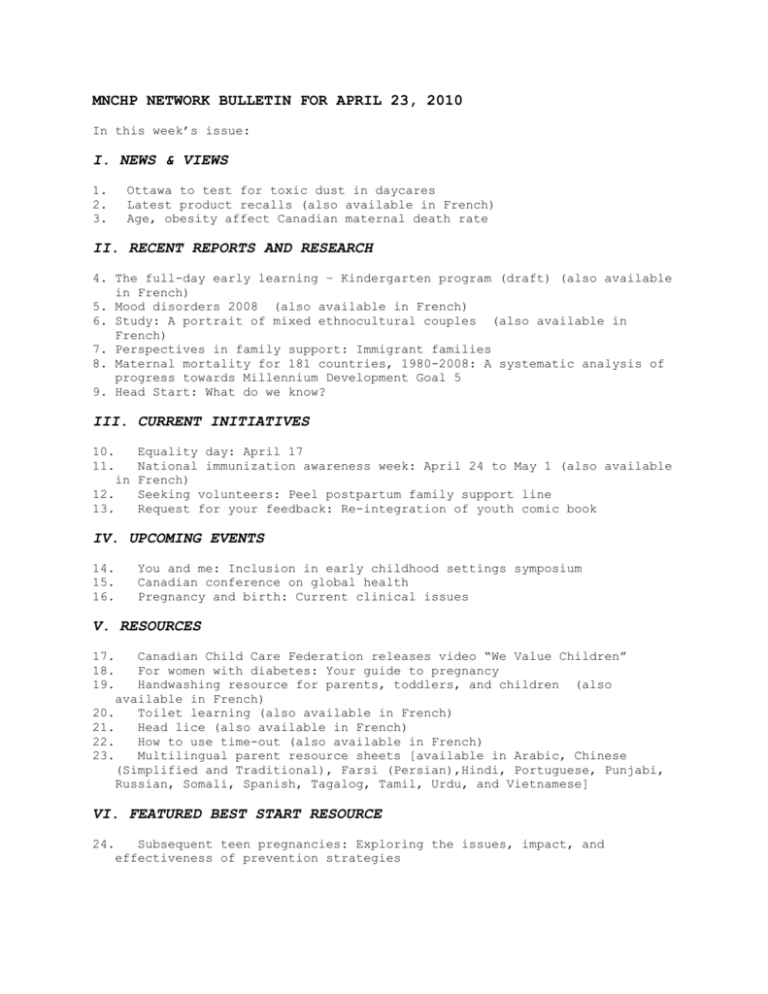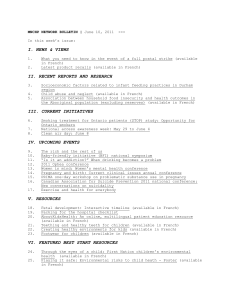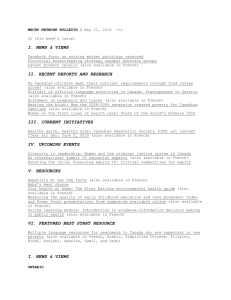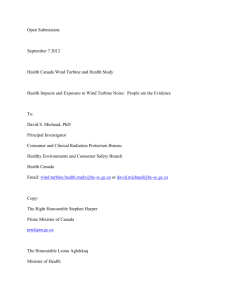Apr-23-2010_plain - Best Start Resource Centre
advertisement

MNCHP NETWORK BULLETIN FOR APRIL 23, 2010 In this week’s issue: I. NEWS & VIEWS 1. 2. 3. Ottawa to test for toxic dust in daycares Latest product recalls (also available in French) Age, obesity affect Canadian maternal death rate II. RECENT REPORTS AND RESEARCH 4. The full-day early learning – Kindergarten program (draft) (also available in French) 5. Mood disorders 2008 (also available in French) 6. Study: A portrait of mixed ethnocultural couples (also available in French) 7. Perspectives in family support: Immigrant families 8. Maternal mortality for 181 countries, 1980-2008: A systematic analysis of progress towards Millennium Development Goal 5 9. Head Start: What do we know? III. CURRENT INITIATIVES 10. 11. Equality day: April 17 National immunization awareness week: April 24 to May 1 (also available in French) 12. Seeking volunteers: Peel postpartum family support line 13. Request for your feedback: Re-integration of youth comic book IV. UPCOMING EVENTS 14. 15. 16. You and me: Inclusion in early childhood settings symposium Canadian conference on global health Pregnancy and birth: Current clinical issues V. RESOURCES 17. 18. 19. Canadian Child Care Federation releases video “We Value Children” For women with diabetes: Your guide to pregnancy Handwashing resource for parents, toddlers, and children (also available in French) 20. Toilet learning (also available in French) 21. Head lice (also available in French) 22. How to use time-out (also available in French) 23. Multilingual parent resource sheets [available in Arabic, Chinese (Simplified and Traditional), Farsi (Persian),Hindi, Portuguese, Punjabi, Russian, Somali, Spanish, Tagalog, Tamil, Urdu, and Vietnamese] VI. FEATURED BEST START RESOURCE 24. Subsequent teen pregnancies: Exploring the issues, impact, and effectiveness of prevention strategies I. NEWS & VIEWS ONTARIO 1. OTTAWA TO TEST FOR TOXIC DUST IN DAYCARES Health Canada is looking for scientists to collect and analyze dust at hundreds of daycares to look for the residue of potentially dangerous substances used in everyday items (Smith, 2010, March 31). This study will target toxins that the government considers priorities for regulation because they are harmful to human health or the environment. They include: bisphenolA, which is banned in baby bottles but is still found in hard plastics and the lining of canned food; non-brominated flame retardants, used in some sealants and caulking; phthalates found in some soft plastic toys and vinyl flooring; pesticides and antibacterial preservative; and scent-producing chemicals found in household cleaning products. The results of the study are expected in 2012 and will be published in peer-reviewed literature (Smith, 2010, March 31). CANADA 2. LATEST PRODUCT RECALLS (also available in French) Note: Products that are recalled for containing lead or barium are in excess of the allowable level per the Canadian Hazardous Products Act (CHPA). Cupcake Shoe Tag for Dawgs Clogs: Contains lead. Posey, Lily, Rose, and Daisy Preschool Girls’ Ski Jackets: Jackets have drawstrings at the waist, which can pose an entanglement hazard to children. Wooden Toys by Daiso: May release small parts; these small parts pose a choking hazard to young children. Clip-on Metallic Toe Ring: Contains lead. Health Canada reminds pregnant women of the importance of food safety English: http://www.hc-sc.gc.ca/ahc-asc/media/advisoriesavis/_2010/2010_49-eng.php French: http://www.hc-sc.gc.ca/ahc-asc/media/advisoriesavis/_2010/2010_49-fra.php Health Canada reminds parents to exercise caution when using infant slings and soft infant carriers English: http://www.hc-sc.gc.ca/ahc-asc/media/advisoriesavis/_2010/2010_36-eng.php French: http://www.hc-sc.gc.ca/ahc-asc/media/advisoriesavis/_2010/2010_36-fra.php Health Canada reminds Canadians to manage caffeine consumption, especially children, pregnant and breastfeeding women, and women who are planning to become pregnant English: http://www.hc-sc.gc.ca/ahc-asc/media/advisoriesavis/_2010/2010_40-eng.php French: http://www.hc-sc.gc.ca/ahc-asc/media/advisoriesavis/_2010/2010_40-fra.php English: http://cpsr-rspc.hc-sc.gc.ca/PR-RP/home-accueil-eng.jsp http://www.hc-sc.gc.ca/cps-spc/advisories-avis/aw-am/index-eng.php French: http://cpsr-rspc.hc-sc.gc.ca/PR-RP/home-accueil-fra.jsp http://www.hc-sc.gc.ca/cps-spc/advisories-avis/aw-am/index-fra.php 3. AGE, OBESITY AFFECT CANADIAN MATERNAL DEATH RATE A recent study analyzing maternal mortality in 181 countries revealed that Canada has one of the lowest death rates in the world with 7 per 100,000 live births in 2008 (Hogan et al., 2010). However, this rate represents a slight rise for 6 per 100,000 live births over the 20-year study period. Dr André Lalonde, executive vice-president of the Society of Obstetricians and Gynaecologists of Canada notes “we are seeing cardiovascular deaths we hadn’t seen before” in Canada (Taylor, 2010, April 14). He explains that the rise in age at which women are having children (with many women having children over 30) and the increase in obesity. He notes that more than 30% of pregnancies are complicated by obesity. http://parentcentral.ca/parent/article/795103 II. RECENT REPORTS AND RESEARCH ONTARIO 4. THE FULL-DAY EARLY LEARNING – KINDERGARTEN PROGRAM (DRAFT) (also available in French) The Government of Ontario (2010) released the Full-Day Early LearningKindergarten Program (Draft version), which contains the learning expectations portion of the draft program document. The introductory portion will provide a broader context for the document, greater descriptions of play-based learning and the roles of the teacher-early childhood educator team. The complete draft document will be implemented in year one early learning sites beginning in September 2010. English: http://www.edu.gov.on.ca/eng/curriculum/elementary/kindergarten.html French: http://www.edu.gov.on.ca/fre/curriculum/elementary/kindergarten.html CANADA 5. MOOD DISORDERS 2008 (also available in French) Statistics Canada (2010, April 9) released a new fact sheet about mood disorders based on data from a survey question that asked about mood disorders diagnosed by a health professional. The percentage of Canadians reporting a diagnosed mood disorder rose from 5.3% in 2003 to 6.8% in 2008. Women reported significantly higher levels of mood disorders than did men. In 2008 the percentages of Ontario and British Columbia residents reporting diagnosed mood disorders were higher than the national average. English: http://www.statcan.gc.ca/pub/82-625-x/2010001/article/11107-eng.htm French: http://www.statcan.gc.ca/pub/82-625-x/2010001/article/11107-fra.htm 6. STUDY: A PORTRAIT OF MIXED ETHNOCULTURAL COUPLES (also available in French) Canada’s population is increasingly diverse and there are marriages or relationships formed between one visible minority group member and one nonmember or between people who belong to two different visible minority groups. According to this study (Statistics Canada, 2010) of 2006 data, there were 289,400 mixed unions in 2006, up 33.1% from 2001. Of the total number of mixed unions, approximately 247,600 couples were comprised of one person who belonged to a visible minority group and someone who was not a visible minority (3.3% of all couples in Canada). The remaining 41,800 mixed unions consisted of couples in which both members belonged to a different visible minority group (0.6% of all couples). In 2006, 5.1% of all couples who lived in a census metropolitan area were in mixed unions, compared with 1.4% of couples who lived outside these areas (Statistics Canada, 2010). English: http://www.statcan.gc.ca/bsolc/olc-cel/olc-cel?catno=11-008X&lang=eng French: http://www.statcan.gc.ca/bsolc/olc-cel/olc-cel?catno=11-008X&lang=fra 7. PERSPECTIVES IN FAMILY SUPPORT: IMMIGRANT FAMILIES FRP Canada released (2010, April 14) their latest journal featuring articles about working with immigrant families. It includes information about the participation of immigrant families in the activities of family resource programs, how to take an “advocacy with” approach to better support families, an overview of phase 2 of FRP Canada’s Welcome Here Project featuring a summary report of lessons learned, reflections on issues of translation and interpretation, and the problem of “data” in cross-cultural contexts. http://www.frp.ca/index.cfm?fuseaction=document.showDocumentByID&nodeID=1&Doc umentID=845 INTERNATIONAL 8. MATERNAL MORTALITY FOR 181 COUNTRIES, 1980-2008: A SYSTEMATIC ANALYSIS OF PROGRESS TOWARDS MILLENNIUM DEVELOPMENT GOAL 5 The Millennium Development Goal 5 (MDG 5) target is a 75% reduction in the maternal mortality ratio (MMR) from 1990 to 2015. This study used a database of 2,651 observations of maternal mortality for 181 countries for 1980 to 2008. The findings reveal an estimated 342,900 maternal deaths worldwide in 2008, down from 526,300 in 1980. More than 50% of all maternal deaths were in six countries in 2008: India, Nigeria, Pakistan, Afghanistan, Ethiopia, and the Democratic Republic of the Congo. http://www.thelancet.com/journals/lancet/article/PIIS0140-6736%2810%29605181/fulltext 9. HEAD START: WHAT DO WE KNOW? Head Start is one of the longest-running and most well-known early childhood programs in the U.S. (Promising Practices Network, 2010). Numerous researchers have attempted to study the impact of Head Start and identify the components of the program that are critical to accomplishing the program's intended outcomes. Questions still remain about the true effectiveness of the program and this article highlights for policymakers and others the reasons why many consider the issue of Head Start's effectiveness to be as of yet unresolved. Some of the challenges for evaluating Head Start are the variation in Head Start program structure, the program changes since its inception, and identifying what Head Start’s impact should be measured against (Promising Practices Network, 2010). http://www.promisingpractices.net/briefs/briefs_headstart.asp III. CURRENT INITIATIVES 10. EQUALITY DAY: APRIL 17 Equality Day marks the adoption of the equality provisions in the Canadian Charter of Rights and Freedoms on April 17, 1985. http://www.etfo.ca/AdvocacyandAction/WomensIssues/EqualityDay/Pages/default.a spx 11. NATIONAL IMMUNIZATION AWARENESS WEEK: APRIL 24 TO MAY 1 (also available in French) The National Immunization Awareness Week website provides a range of free resources that can be used in communities such as “Immunization saves lives: 100 years ago…and today!”, “0-2 years old: all aboard!”, “Child/student/young adult: stay on track!”, “Adults and seniors: right on schedule!”, “It’s time to immunize”, and “immunization: get the facts”. English: http://www.immunize.cpha.ca/en/events/niaw.aspx French: http://www.immunize.cpha.ca/fr/events/niaw.aspx 12. SEEKING VOLUNTEERS: PEEL POSTPARTUM FAMILY SUPPORT LINE This telephone support line will formally be launched June 1, 2010. It will be staffed with trained volunteers, and will provide caring, emotional support to women and their family members during the prenatal and postpartum period. Features of the line will include: Outbound support calls (available now) for clients who need ongoing support. Support is available at the client’s request or based on referral from family visitors, HBHC staff, social workers, etc. Inbound support from 10am – 10pm (launching June 1st 2010). Support in English, Hindi/Urdu/Punjabi, Spanish, Portuguese and Mandarin/Cantonese. Peel Postpartum Mood Disorder Program is currently recruiting volunteers with a passion for supporting women and their families during the prenatal and postpartum period. Volunteers will receive extensive training and will have the opportunity to provide emotional support to callers during this challenging time. http://www.pmdinpeel.ca/ 13. REQUEST FOR YOUR FEEDBACK: RE-INTEGRATION OF YOUTH COMIC BOOK The Healthy Aboriginal Network received funding for a comic book on reintegrating youth back into their community after contact with the justice system. This book is targeted for those youth, and their workers, families, and friends. This ‘how to’ book will be illustrated and told in story. Sean Muir, Executive Directory of the Healthy Aboriginal Network, is requesting strategies for making this transition back to the community after contact with the justice system. The deadline for feedback is April 30, 2010. The strategies will be focus group tested with youth May 3 -5, 2010. Please send your strategies to sean@thehealthyaboriginal.net IV. UPCOMING EVENTS This section lists events that have not been included in earlier editions of the bulletin or listserv postings. For the details of these events and a complete list of events noted in previous bulletins and postings, including contact information, links to organizations, and descriptions, see http://www.beststart.org/events/otherevents.php ONTARIO 14. YOU AND ME: INCLUSION IN EARLY CHILDHOOD SETTINGS SYMPOSIUM May 10-11, 2010: Toronto, ON Hosted by: City of Toronto, AECEO, The Macaulay Child Development Centre, and Ryerson University http://www.ryerson.ca/ece/ 15. CANADIAN CONFERENCE ON GLOBAL HEALTH October 31-November 3, 2010: Ottawa, ON Hosted by: The Canadian Society for International Health http://www.csih.org/en/conference/registration.asp 16. PREGNANCY AND BIRTH: CURRENT CLINICAL ISSUES December 9-10, 2010: Toronto, ON Hosted by: Sunnybrook Health Sciences Centre http://www.sunnybrook.ca/research/?page=sri_proj_cmicr_events V. RESOURCES 17. CANADIAN CHILD CARE FEDERATION RELEASES VIDEO “WE VALUE CHILDREN” The Canadian Child Care Federation (CCCF) (2010) released a new video called “We value children”. You can view the video on the CCCF website at http://www.cccf-fcsge.ca/video/cccf.html or on You Tube at http://www.youtube.com/watch?v=StNsg6Fr3LE. You can also join CCCF on Facebook http://www.facebook.com/group.php?gid=5657406573 RESOURCES FOR PARENTS/CAREGIVERS 18. FOR WOMEN WITH DIABETES: YOUR GUIDE TO PREGNANCY The National Diabetes Information Clearinghouse (NDIC) (2008) released an illustrated, 44-page booklet that includes information about checking and controlling blood glucose, maintaining a healthy diet, staying physically active and taking tests and diabetes medications during pregnancy. The importance of planning for pregnancy and getting blood glucose levels under control before pregnancy to decrease the risk of birth defects associated with diabetes is emphasized. Logs for recording daily blood glucose and ketone levels, food intake, and physical activity are provided. http://www.diabetes.niddk.nih.gov/dm/pubs/pregnancy/ 19. HANDWASHING RESOURCE FOR PARENTS, TODDLERS, AND CHILDREN (also available in French) This illustrated resource (Canadian Institute for Child Health, 2010) provides information about how to prevent the spread of infections, how infections are spread, when hands need to be washed, and tips for making handwashing easy and fun. English: http://www.cich.ca/index_eng.html French: http://www.cich.ca/French/index-f.html 20. TOILET LEARNING (also available in French) This factsheet (Caring for Kids, 2008) provides information about toilet learning including how to know when a child is ready for toilet learning, how to help a child learn to use the toilet, what to do if toilet learning does not work, and information about night-time toilet learning. English: http://www.caringforkids.cps.ca/growing&learning/ToiletLearning.htm French: http://www.soinsdenosenfants.cps.ca/grandir&apprendre/Apprentissageproprete.h tm 21. HEAD LICE (also available in French) This factsheet (Caring for Kids, 2009) provides information about how to cope with head lice. It includes a picture of what head lice look like, and information about: how they spread, how to check for head lice, treatment, disinfecting household items, and whether children should stay home from child care or school. English: http://www.caringforkids.cps.ca/whensick/HeadLice.htm French: http://www.soinsdenosenfants.cps.ca/enfantmalade/PouxDeTete.htm 22. HOW TO USE TIME-OUT (also available in French) Information is provided about how to use time out including how long it should last, dealing with other children (e.g., siblings) when a child is in time-out, and how to end time-out (Caring for Kids, 2009). English: http://www.caringforkids.cps.ca/behaviour&parenting/TimeOut.htm French: http://www.soinsdenosenfants.cps.ca/Comportement&parents/PeriodeDeReflexion.h tm 23. MULTILINGUAL PARENT RESOURCE SHEETS [Available in Arabic, Chinese (Simplified and Traditional), Farsi (Persian), Hindi, Portuguese, Punjabi, Russian, Somali, Spanish, Tagalog, Tamil, Urdu, and Vietnamese] The following topics are covered: Building active habits, family routines, parents at play, promoting positive behaviour, supporting children’s play, process not product, the pleasures of reading aloud, change waiting time to play time, singing through the day, and connecting through stories. http://www.welcomehere.ca/index.cfm?fuseaction=page.viewpage&pageid=673 VI. FEATURED BEST START RESOURCE RESOURCE FOR SERVICE PROVIDERS 24. SUBSEQUENT TEEN PREGNANCIES: EXPLORING THE ISSUES, IMPACT, AND EFFECTIVENESS OF PREVENTION STRATEGIES This report (Best Start Resource Centre, 2009) reviews and discusses research on the factors associated with subsequent teen pregnancies, including statistical trends, economic and medical consequences, and effectiveness of prevention practices. http://www.beststart.org/resources/preconception/subsequent_teen_preg.pdf The Best Start Resource Centre thanks you for your interest in, and support of, our work. Best Start permits others to copy, distribute or reference the work for noncommercial purposes on condition that full credit is given. Because our MNCHP bulletins are designed to support local health promotion initiatives, we would appreciate knowing how this resource has supported, or been integrated into, your work (mnchp@healthnexus.ca). Please note that the Best Start Resource Centre does not endorse or recommend any events, resources, or publications mentioned in this bulletin. Click here to access Health Nexus’ other e-bulletins and listservs: In English: OHPE - The free weekly Ontario Health Promotion E-mail bulletin (OHPE) offers a digest of news, events, jobs, feature articles on health promotion issues, resources, and much more, to those working in health promotion. http://www.ohpe.ca/ Click4HP - An open, facilitated public listserv, is an international dialogue on health promotion. Participants exchange views on issues and ideas, provide leads to resources, and ask questions about health promotion. https://listserv.yorku.ca/archives/click4hp.html Health Nexus Today - Health Nexus Today is our Blog on health promotion. According to Google, "Blog is short for weblog - a journal or newsletter that is frequently updated and intended for the general pubic." Find the latest on health promotion including breaking news, highlights, studies, and issues in health promotion and the determinants of health in Canada and internationally. http://www.blogs.healthnexussante.ca/ In French: French distribution list – The free distribution list offers information in French on maternal, newborn, and child health promotion topics. http://www.meilleurdepart.org/index_fr.html Le Bloc-Notes – The biweekly French language bulletin provides information on health promotion. http://leblocnotes.ca/









